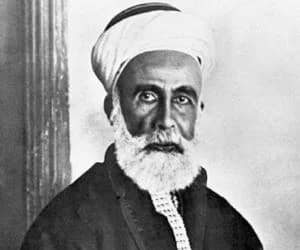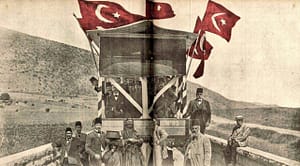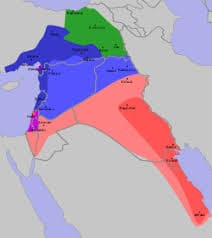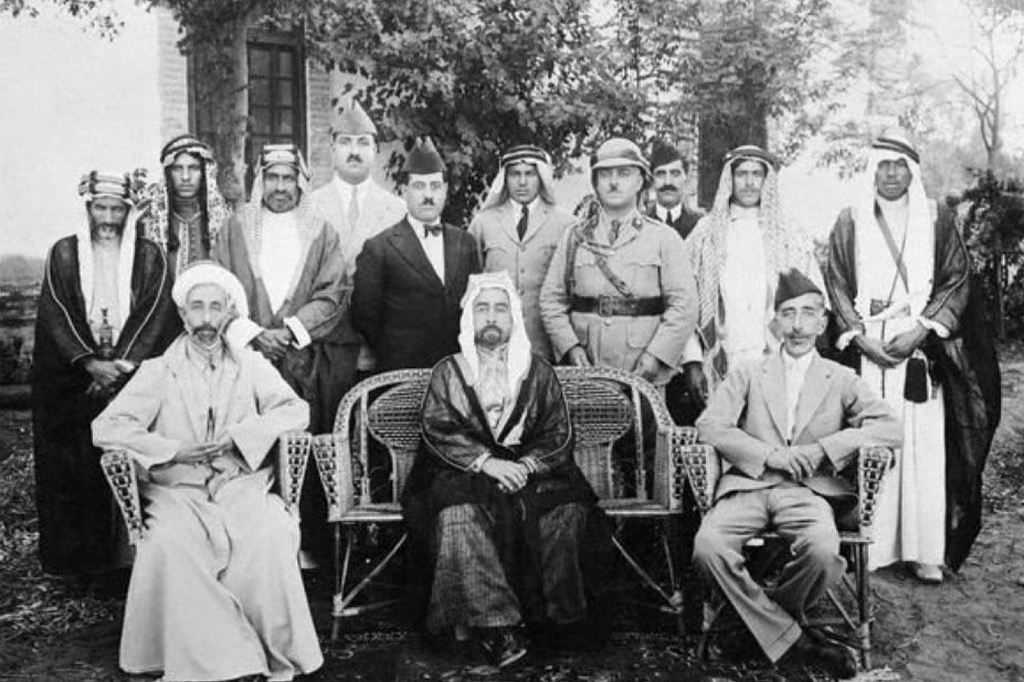The Emergence of the Arab Revolt, the Ottoman Situation in Palestine and the Leading Players
In the early 20th century, during the decline of the Ottoman Empire, the Arab Revolt erupted, heralding a major change in the Arab geography. This revolt had its roots in the social, political and economic unrest that had accumulated under the long rule of the Ottoman Empire. In particular, the rise of Arab nationalism, the reaction against the Ottoman centralist policies and the growing British influence in the region were among the main causes of the revolt. While Arab nationalism led Arabs to express their identity and demands for independence more strongly, the Ottoman centralist policies were aimed at suppressing these demands.
This increased discontent in the Arab society against the Ottoman rule and sparked a rebellion. The growing influence of the British in the region was aimed at protecting and expanding their own interests by taking advantage of the Ottoman weakness. For this purpose, the British aimed to weaken the Ottoman Empire by supporting the Arab Revolt. 1
The situation of the Ottoman Empire in Palestine also played a critical role in the outbreak of the revolt. Under Ottoman rule since the 16th century, Palestine faced various problems with the weakening of the empire. Economic difficulties, land ownership problems and increasing taxes increased popular discontent. In particular, the Ottoman territorial policies in Palestine increased the Arab people's fear of losing their lands and strengthened their reaction against the Ottoman rule. The sale of land to Jewish immigrants was perceived as an attempt to change the demographic structure in the region and caused concern among Arabs. Economic hardship, on the other hand, led to the impoverishment of the population and worsening living conditions. This further fueled Arab resentment against the Ottomans. 2

The role of Sharif Hussein and the British was decisive in the start and spread of the Arab Revolt. Sharif Hussein, Emir of Mecca, led the revolt against the Ottomans and led the Arab struggle for independence. Hussein believed that Arabs had the right to self-determination and opposed the oppressive Ottoman rule. The British, on the other hand, supported the Arab Revolt in order to weaken the Ottoman Empire and protect their interests in the region. Especially British intelligence officer T.E. Lawrence (Lawrence of Arabia) played an important role in the military and political direction of the revolt.
Thanks to his command of Arab culture and language, Lawrence established close relations with Arab leaders and was instrumental in organizing the revolt. The correspondence and agreements between Sharif Hussein and the British influenced the course and results of the revolt. In these correspondences, while the British promised independence to the Arabs, they did not hide their intention to control the region for their own interests. 3
Ottoman Policies in Palestine: The Seeds of Repression and Revolt against Nationalism
The Ottoman Empire's Palestine policies in the late 19th and early 20th centuries played an important role in the emergence of the Arab Revolt. Especially during the reign of Abdul Hamid II, the Ottoman administration was concerned about the rise of Arab nationalism and tried to contain this movement. For this purpose, restrictions were imposed on Arabic education and cultural activities, and Arab leaders and intellectuals were suppressed. These repressive policies increased discontent in Arab society against Ottoman rule and further inflamed nationalist sentiments. 4
The Ottoman territorial policies in Palestine were also influential in the Arab Revolt. The Empire tried to change the demographic structure in the region by selling lands in Palestine to Jewish immigrants. This increased the Arab people's fear of losing their land and strengthened their reaction against the Ottoman rule. Moreover, the Ottoman economic policies in Palestine led to the impoverishment of the Arab people and worsened their living conditions. These economic hardships further fueled Arab resentment against the Ottomans. 2
The Ottoman oppressive policies and economic problems in Palestine paved the way for the strengthening of Arab nationalism and increased opposition to the Ottoman rule. In this environment, the Arab Revolt led by Sharif Hussein was an important step towards the end of the Ottoman rule in Palestine. While the revolt shook the Ottoman authority in the region, it also caused the Palestinian question to become an international issue and laid the foundation for the conflicts that continue to this day. 1
The Beginning and Spread of the Arab Revolt: From Mecca to the Desert, the Struggle against the Ottoman Empire
The Arab Revolt began on June 10, 1916 when Sharif Hussein revolted against the Ottomans in Mecca. Arab forces led by Hussein soon captured Mecca and achieved the first major success of the revolt. 5 This victory encouraged other Arab tribes to join the revolt and led to its rapid spread from the Hijaz region.
British military support, and in particular the influence of T.E. Lawrence (Lawrence of Arabia), played a critical role in the success of the Arab Revolt. Lawrence assisted the Arab forces with military advice and strategic planning. At the same time, he contributed to the more effective conduct of the revolt by ensuring coordination between Arab tribes. The arms, ammunition and financial support provided by the British also gave the Arab forces an important advantage in their struggle against the Ottoman Empire. 6
The Ottoman Empire was caught unprepared for the start of the Arab Revolt. The rapid spread of the revolt and the support of the British put the Ottoman forces in a difficult situation. The Ottoman army fought battles in various regions to suppress the Arab Revolt. However, their ill-equipped for desert warfare, inadequate logistical support and the harsh conditions in the Arab geography prevented the Ottoman forces from succeeding. In addition, the deep discontent of the Arab tribes against the Ottoman rule led to the further strengthening of the revolt. 7
Military Strategies of the Arab Revolt

The Arab Revolt was characterized by unique military strategies adapted to the desert conditions, beyond the traditional tactics of warfare. British intelligence officer T.E. Lawrence (Lawrence of Arabia) played a key role in the development and implementation of these strategies as a military advisor to the Arab forces. By analyzing the strengths and weaknesses of the Ottoman army, Lawrence developed guerrilla tactics that made the best use of the Arab tribes' warrior qualities. 6

One of the most important military strategies of the Arab Revolt was attacks on the Ottoman Hejaz Railway. As this railroad was a vital logistical supply line for the Ottoman army, Arab forces regularly attacked the railroad in an attempt to cut off the Ottoman supply lines. This tactic limited the mobility of the Ottoman army and gave the Arab forces a significant advantage. 5
The Arab forces were equipped with light weapons and fast-moving camels suitable for desert conditions. This enabled them to fight more agilely and effectively against the heavy weapons and slow-moving troops of the Ottoman army. The Arab warriors' geographical knowledge and experience in the desert also gave them a significant advantage over the Ottomans. Using tactics such as ambushes, raids and rapid retreats, the Arab forces were able to wear down the Ottoman army. 7
Social, Political and Economic Effects of the Arab Revolt: Waves Changing the Destiny of the Region
The Arab Revolt was a turning point that left a deep mark on the social, political and economic structure of the Middle East. It accelerated the rise of Arab nationalism and strengthened the Arab desire for self-determination. Nationalist sentiments, which had been suppressed under the long rule of the Ottoman Empire, were further inflamed by the revolt. As the Arab community struggled against a common enemy, the Ottoman Empire, they began to express their own identity and demands for independence more forcefully. 8
The Ottoman Empire lost much of its prestige in the region as a result of the Arab Revolt. The success of the revolt and the British support exposed the Ottoman weakness and lack of ability to control the region. This undermined the Ottoman prestige in the region and completely destroyed the Arab people's trust in Ottoman rule. The revolt paved the way for the dissolution of the Ottoman Empire and the establishment of a new political order in the Middle East. 9
The Sykes-Picot Agreement was one of the most important political outcomes of the Arab Revolt. This secret agreement between Britain and France envisioned the partition of the Ottoman Empire and the division of control of the Middle East between the two powers. It was a major disappointment to Arab nationalist hopes for independence and sparked deep debate about the future of the region. The effects of the Sykes-Picot Agreement are still felt in the Middle East today. 10
The Arab Revolt also caused significant changes in the economic structure of the region. The collapse of the Ottoman Empire and the establishment of the Anglo-French mandates reshaped economic relations in the region. While traditional trade routes and economic structures were disrupted, new economic dependencies emerged. British and French companies took control of oil and other resources in the region and began to implement economic policies in line with their own interests. This deepened economic inequalities in the region and led to long-term social and political problems. 11
The Role of Women in the Arab Revolt:
Although the Arab Revolt is generally perceived as a struggle in which men were at the forefront, women also played important roles in this process. Their support behind the front lines was critical to the success of the revolt. Women provided care for wounded soldiers, supplied food and water, and engaged in communication and intelligence activities. They also kept nationalist sentiments alive in Arab society and increased support for the revolt. 12
In the Arab Revolt, some female figures stood out for their leadership qualities and courage. One of them was Princess Nura bint Sibah, an advisor to Emir Feisal, daughter of Sharif Hussein. With her diplomatic skills and political acumen, Princess Nura played an important role in bringing international recognition to the Arab Revolt. She also defended Arab interests in negotiations with the British and fought for women's rights. 13
Another important female figure was Sharifa Hazima bint Nasser, wife of Sharif Hussein and considered the spiritual leader of the Arab Revolt. Sharifa Hazima called on Arab women to support the revolt and coordinated their work behind the front lines. She also made important strides in the education and social status of women in Arab society. 14
Cultural Reflections of the Arab Revolt
The Arab Revolt was not only a political and social event, but also a source of inspiration that left deep traces in Arab culture and art. In literature, art and music, the effects of the revolt were reflected both in the works reflecting the testimonies of the period and in the productions of subsequent generations. The uprising was frequently treated as a theme in the works of Arab poets and writers, in which they expressed nationalist sentiments, stories of heroism and longing for independence. In particular, the life and adventures of T.E. Lawrence, one of the symbolic figures of the rebellion, were the subject of many literary works. 15
The Arab Revolt also found its place in the visual arts. Painters portrayed the important moments of the revolt, its heroes and the atmosphere of desert battles on their canvases. Photographs and visual materials from the uprising period were transformed into works of both documentary and artistic value. In music, folk songs and anthems reflecting the joy and sadness of the uprising were composed. These works have become part of the collective memory of the Arab community and transmitted the spirit of the uprising to future generations. 16
The Arab Uprising has played out in social memory in different ways and its narratives have varied over time. For some, the revolt was seen as an epic of heroism and a symbol of the struggle for independence. Others took a critical view of the political instability and division it brought to the region. In both cases, however, the Arab Revolt has been an important part of the Arab community's shared past and influential in identity construction. The narratives of the uprising have been passed down from generation to generation and have remained vivid in the collective memory and are still being debated today. 17
Consequences and Legacy of the Arab Revolt: The Rebirth and Pangs of the Middle East
The Arab Revolt played a decisive role in the collapse of the Ottoman Empire and the redrawing of the political map of the Middle East. The revolt accelerated the Ottoman defeat in the First World War and triggered the disintegration of the empire. As the Ottoman rule in the Middle East came to an end, the region entered a new era. However, this new era brought with it many problems. 18
The Arab Revolt also sparked debates on the future of Palestine. British promises to Palestine and the emergence of the Sykes-Picot Agreement shattered Arab hopes for independence. In Palestine, which remained under the British mandate, tensions between Arabs and Jews increased and this formed the basis of the conflicts that continue to this day. The effects of the Arab Revolt on Palestine are still at the center of political and social problems in the region. 19
After the Arab Revolt, a new political order was established in the Middle East. The British and French mandates divided the region among themselves and drew new borders. This ignored the ethnic and religious differences in the region, setting the stage for long-term instability and conflict. The legacy of the Arab Revolt is still evident in the Middle East today, with ongoing political tensions, border disputes and sectarian conflicts. 20
Balfour Declaration
The Balfour Declaration emerged on November 2, 1917, with a letter sent to Lord Rothschild by then British Foreign Secretary Arthur James Balfour. In this letter, it was stated that the British government welcomed the idea of establishing a "Jewish homeland" in Palestine. In the complex political atmosphere of the First World War, the Declaration was a step taken to protect British interests in the region and to gain Jewish support.
The Balfour Declaration was notable for its brevity and vagueness. It did not include any guarantee that the political and civil rights of the Arabs living in Palestine would be protected, while the term "Jewish homeland" was ambiguous as to what exactly it meant. This ambiguity would form the basis of the conflicts and disputes in Palestine in the years to come.
The publication of the Declaration was greeted with great enthusiasm by the Zionist movement. Jews were filled with the hope of having their own land, which they had longed for centuries. However, for the Arabs living in Palestine, this was a source of great concern and reaction. Arabs opposed the declaration, believing that their rights and future in their own land were jeopardized.
The Balfour Declaration went down in history as a document that profoundly affected the fate of the Middle East. The developments that followed the Declaration led to the establishment of a Jewish state in Palestine, the displacement of Arabs and conflicts that continue to this day. The Balfour Declaration continues to be a controversial issue in terms of international law and human rights.
Conclusion Echoes of the Arab Revolt
The Arab Revolt was a turning point in the early 20th century that changed the fate of the Middle East. Accelerating the fall of the Ottoman Empire, strengthening Arab nationalism and redrawing the political map of the region, the revolt still resonates today with its historical significance. The impact of the revolt was not limited to the political and social spheres, but also left deep traces in the cultural and economic spheres. The rebellion accelerated the defeat of the Ottoman Empire in the First World War, leading to the disintegration of the multinational structure and the emergence of modern Middle Eastern states.
At the same time, it led to the awakening of national consciousness and the desire for self-determination in Arab society. This awakening also affected cultural and artistic production in the region, leading to the prominence of nationalist themes in Arab literature, music and cinema. Economically, the collapse of the Ottoman Empire and the economic policies of the newly established states reshaped economic relations and the distribution of resources in the region. 21

The present-day effects and repercussions of the Arab Revolt are manifested in the Middle East's political instability, border disputes and sectarian conflicts. The new political order established in the aftermath of the revolt ignored the ethnic and religious differences in the region, leading to long-term problems. The artificial borders created by the Sykes-Picot Agreement united different ethnic and religious groups under the umbrella of the same state, creating the basis for today's border disputes and internal conflicts. This has created an environment of constant instability and conflict in the region. Another important consequence of the Arab Revolt was the emergence of the Palestinian question and its continuing complexity to this day. Contradictory British promises regarding Palestine and conflicts of interest in the region formed the basis of the Arab-Israeli conflict. 17
The Arab Revolt also allowed the Arab community to more strongly express its identity and desire for independence. The revolt accelerated the rise of Arab nationalism and inspired the Arab struggle for self-determination. This paved the way for the emergence of anti-colonial movements and independence struggles. These effects of the Arab Revolt are evident in the decolonization process in the Middle East throughout the 20th century and in popular movements such as the Arab Spring today. The national consciousness and desire for independence generated by the revolt plays an important role in the Arab community's efforts to shape its own future. 22
The Arab Revolt, with its historical significance and present-day impact, is critical to understanding the past and present of the Middle East. Research on the causes, development, consequences and legacy of the revolt will help us understand the origins of current problems in the region and make more informed predictions for the future. The legacy of the revolt is still debated and subject to different interpretations today. However, there is no denying the central role of the Arab Revolt in the modern history of the Middle East and its profound impact on political, social and cultural developments in the region.
Sources:
- Rogan, E. (2011). The Fall of the Ottomans: The Great War in the Middle East.[↩][↩]
- Karsh, E. (2010). Palestine Betrayed.[↩][↩]
- Anderson, S. (2014). Lawrence in Arabia: War, Deceit, Imperial Folly and the Making of the Modern Middle East.[↩]
- Kayali, H. (1997). Arabs and Young Turks: Ottomanism, Arabism, and Islamism in the Ottoman Empire, 1908-1918.[↩]
- Murphy, D. (2016). The Arab Revolt 1916-18: Lawrence Sets Arabia Ablaze.[↩][↩]
- Wilson, J. (1992). Lawrence of Arabia: The Authorized Biography of T.E. Lawrence.[↩][↩]
- Erickson, E. J. (2001). Ordered to Die: A History of the Ottoman Army in the First World War.[↩][↩]
- Cleveland, W. L. (2013). A History of the Modern Middle East.[↩]
- Fromkin, D. (1989). A Peace to End All Peace: The Fall of the Ottoman Empire and the Creation of the Modern Middle East.[↩]
- MacMillan, M. (2003). Paris 1919: Six Months That Changed the World.[↩]
- Khalidi, R. (1997). Palestinian Identity: The Construction of Modern National Consciousness.[↩]
- Muslih, M. (2005). The Origins of Palestinian Nationalism.[↩]
- Rappaport, H. (2007). Encyclopedia of Women Social Reformers.[↩]
- Zeidan, J. T. (1995). Arab Women Novelists: The Formative Years and Beyond.[↩]
- Dawn, C. E. (1969). From Ottomanism to Arabism: Essays on the Origins of Arab Nationalism.[↩]
- Antonius, G. (1938). The Arab Awakening: The Story of the Arab National Movement.[↩]
- Gelvin, J. L. (2011). The Modern Middle East: A History.[↩][↩]
- Quataert, D. (2005). The Ottoman Empire, 1700-1922.[↩]
- Louis, W. R. (2006). The British Empire in the Middle East, 1945-1951: Arab Nationalism, the United States, and Postwar Imperialism.[↩]
- Sluglett, P. (2014). Britain in Iraq: Contriving King and Country, 1914-1932.[↩]
- Rogan, E. (2009). The Arabs: A History.[↩]
- Hourani, A. (1991). A History of the Arab Peoples.[↩]

